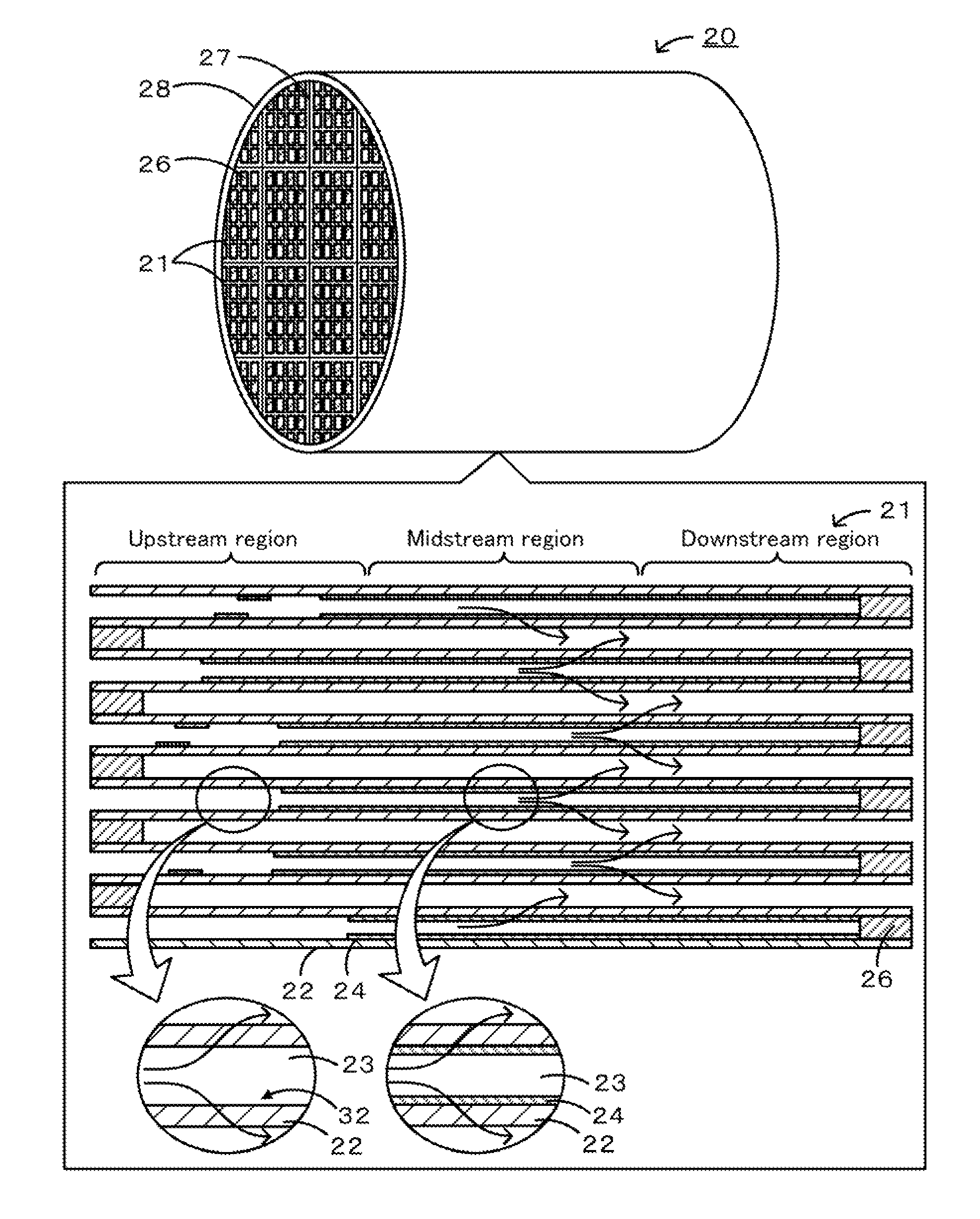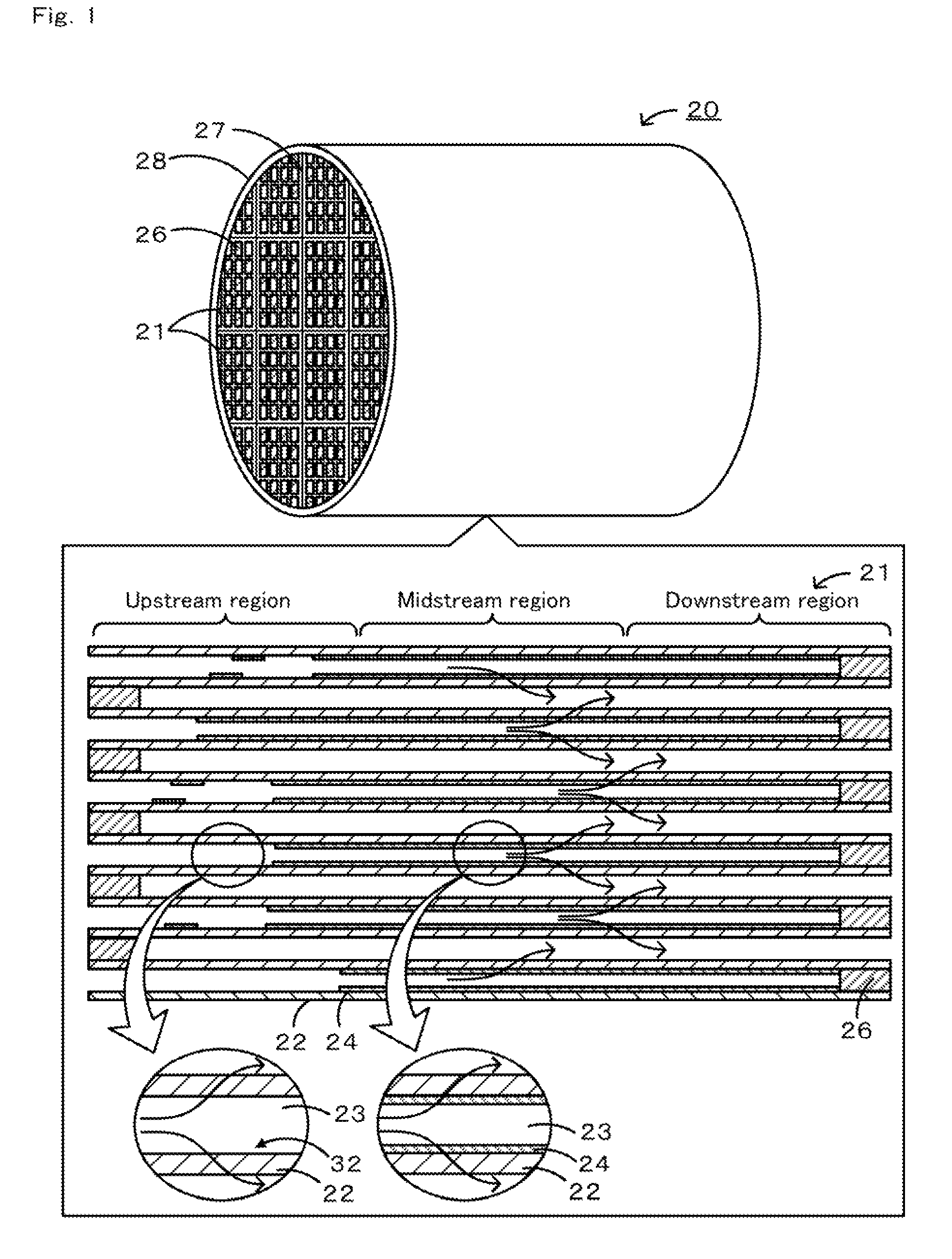Honeycomb filter
a filter and honeycomb technology, applied in the field of honeycomb filters, can solve the problems of difficult to increase the temperature of the entire honeycomb filter, increase the exhaust gas flow, etc., and achieve the effect of facilitating the removal of components contained
- Summary
- Abstract
- Description
- Claims
- Application Information
AI Technical Summary
Benefits of technology
Problems solved by technology
Method used
Image
Examples
examples
[0050]Specific examples of the manufacture of a honeycomb filter will be described below.
[0051][Manufacture of Honeycomb Filter (DPF)]
[0052]A SiC powder and a metallic Si powder were mixed at a mass ratio of 80:20. Methylcellulose, hydroxypropoxylmethylcellulose, a surfactant, and water were added to the mixture, which was then kneaded to prepare a plastic pug. The pug was extruded through a die to form a honeycomb segment formed product having a desired shape. The honeycomb segment was formed such that the cell shape in a cross section perpendicular to the exhaust gas flow direction was tetragonal, the thickness of the partition portion was 300 μm, the cell pitch was 1.47 mm, the cross section was 35 mm×35 mm, and the length was 152 mm. The honeycomb segment formed product was dried using a microwave and then with hot air, was sealed, was calcined in an oxidizing atmosphere at 550° C. for three hours, and was baked in an inert atmosphere at 1400° C. for two hours. The sealing porti...
examples 1 to 6
[0061]In accordance with the conditions for manufacturing the honeycomb filter described above, a honeycomb segment was formed such that the thickness of the partition portion was 304.8 μm and the cell width was 1.16 μm square. The thickness distribution treatment of the trapping layer was performed such that the undeposited region length percentage was 5%, the undeposited region area percentage in a cross section was 100%, and the average thickness of the trapping layer was 40 μm. The resulting honeycomb filter was referred to as Example 1. Honeycomb filters manufactured in the same manner as in Example 1 except that the undeposited region length percentage was 10%, 15%, 20%, 25%, or 30% were referred to as Examples 2 to 6, respectively.
examples 7 to 14
[0063]The thickness distribution treatment of the trapping layer was performed under the same conditions for manufacturing the honeycomb filter described above except that the undeposited region length percentage was 15%, the average thickness of the trapping layer was 40 μm, and the undeposited region area percentage in a cross section was 6%, 8%, 10%, 15%, 20%, 30%, 50%, or 80%. The resulting honeycomb filters were referred to as Examples 7 to 14, respectively.
[0064][Measurement of Purification Efficiency]
[0065]The DOC and the DPF manufactured as described above were subjected to aging. Simulating the mileage of approximately 200,000 km, the DOC and the DPF were subjected to aging in the atmosphere at 850° C. for 10 hours. After aging, the purification efficiency, the pressure loss due to PM deposition, and the PM trapping efficiency of the DOC and the DPF were measured. For the measurement of purification efficiency, 8 g / L of PM was deposited at 2500 rpm at 60 Nm on the DOC and t...
PUM
| Property | Measurement | Unit |
|---|---|---|
| partition thickness tp | aaaaa | aaaaa |
| partition thickness tp | aaaaa | aaaaa |
| thickness tp | aaaaa | aaaaa |
Abstract
Description
Claims
Application Information
 Login to View More
Login to View More - R&D
- Intellectual Property
- Life Sciences
- Materials
- Tech Scout
- Unparalleled Data Quality
- Higher Quality Content
- 60% Fewer Hallucinations
Browse by: Latest US Patents, China's latest patents, Technical Efficacy Thesaurus, Application Domain, Technology Topic, Popular Technical Reports.
© 2025 PatSnap. All rights reserved.Legal|Privacy policy|Modern Slavery Act Transparency Statement|Sitemap|About US| Contact US: help@patsnap.com



